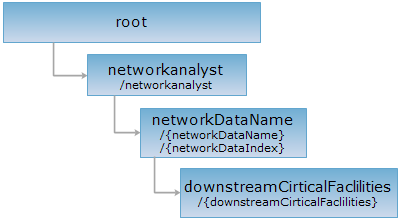
<networkDataName_uri>/downstreamcirticalfaclilities[.<format>]
The downstreamcirticalfaclilities resource is a network analysis resource used for search critical facilities downstream.
To search critical downstream facilities is to search critical facility nodes by specified edges or nodes. ID array of critical nodes or ID array of critical edges will be returned.
Supported Methods:
Supported output formats: rjson, json, html, xml.

Implement the HTTP request on the following URI, where supermapiserver is the server name, with rjson being the output format.
http://supermapiserver:8090/iserver/services/facility/rest/networkanalyst/WaterNet@FacilityNet/downstreamcirticalfaclilities.rjson
Gets ID array of critical nodes or ID array of critical edges
Execute a GET request on downstreamCirticalFaclilities resource. Following arguments need to be included within URI:
| Name | Type | Description |
| sourceNodeIDs | int | [Required] ID array to specify facility nodes. |
| edgeID | int | [Required] The edgeID in network analysis. The request URI shall whether includes edgeID or nodeID, but not both at the same time. |
| nodeID | int | [Required] The nodeID in network analysis. The request URI shall whether includes nodeID or edgeID, but not both at the same time. |
| isUncertainDirectionValid | boolean | Whether edges with uncertain direction is effective. If it is true, the anaysis will keep going down when encounting ucertain direction. Otherwise, it will stop the ansysis in this direction. |
Execute GET request on downstreamCirticalFaclilities resource. The main response message entity consists of ID array of critical nodes and ID array of downstream edges. The representation structure is as follows:
| Field | Type | Description |
| cost | double | Cost in network analysis result. |
| edges | int | ID array of edges in network analysis result. |
| normalNodes | int | ID array of nodes in network analysis result. |
Execute GET request on upstreamCirticalFaclilities resource:http://supermapiserver:8090/iserver/services/facility/rest/networkanalyst/WaterNet@FacilityNet/downstreamcirticalfaclilities.rjson?sourceNodeIDs=%5B75,76,77%5D&edgeID=75&isUncertainDirectionValid=true. The returned resource descirption in rjson format is as follows:
The response result returned is as follows:
{
"cost": 0,
"edges": [
75,
92,
101,
102
],
‘nodes": [76]
}
Asks for the response identical to the one that would correspond to a GET request, but without the response body. This is useful for retrieving meta-information contained in response headers, without having to transport the entire content. The meta-information includes the media-type, content-encoding, transfer-encoding, content-length, etc.
HEAD request can be used to check whether the downstreamCirticalFaclilities resource exists, or whether the the client has the permission to access it. It can also determine if the downstreamCirticalFaclilities resource supports an output format <format> if performed on a URI with .<format> included.